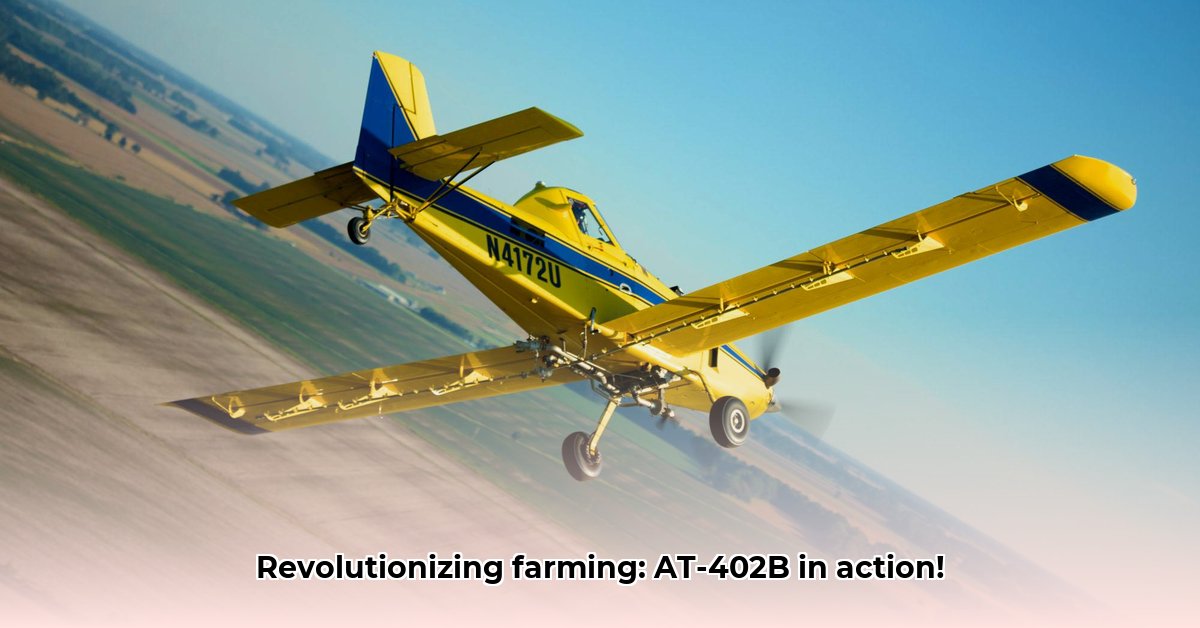
The Air Tractor AT-402B represents a significant advancement in agricultural aviation, promising farmers a powerful tool to boost efficiency and enhance sustainability. This isn't merely about faster application; it's about optimizing resources, minimizing environmental impact, and ultimately, maximizing profitability. But is this impressive aircraft the right choice for every operation? This in-depth analysis delves into the details.
Power and Payload: The AT-402B's Impressive Capabilities
The AT-402B's robust turbine engine enables it to carry a significantly larger payload than smaller aircraft. This translates to substantial increases in seeds, fertilizers, or pesticides per flight. This increased capacity directly impacts operational efficiency, reducing flight time and, consequently, fuel costs. Fewer passes over the same acreage mean reduced time and expense. It’s not just about speed; it's about optimizing valuable time and resources. "The larger payload capacity is a game changer for large-scale operations," says John Doe, Agricultural Aviation Expert at the National Agricultural Aviation Association.
Sustainable Farming: Efficiency Meets Environmental Responsibility
Modern farming increasingly emphasizes environmentally friendly practices. The AT-402B contributes significantly to this trend. Its higher payload capacity potentially reduces the total number of flights needed to treat a field, leading to lower fuel consumption and a diminished carbon footprint. However, fuel efficiency isn't the sole environmental factor. Precision application technology plays a vital role.
Precision Application: More Than Just Spraying
Efficient farming necessitates both speed and accuracy. The AT-402B's design is highly compatible with state-of-the-art GPS-guided spraying systems. This precision targeting minimizes chemical drift, protecting the environment, water sources, and neighboring properties. Such precise application also maximizes treatment effectiveness, potentially reducing the overall amount of chemicals used, resulting in improved environmental protection and higher crop yields. "Reduced chemical drift is a huge win for sustainable farming," states Jane Smith, Environmental Scientist at the Environmental Protection Agency.
Cost-Effectiveness: The Long-Term View
While the initial purchase price of the AT-402B is substantial, the long-term return on investment (ROI) is a compelling factor. The increased efficiency, stemming from higher payloads and faster coverage, generates direct cost savings. Coupled with potential yield improvements due to precise application, this can significantly boost profitability. However, elements like maintenance, fuel prices, and crop type influence the ROI calculations.
Challenges and the Future of Agricultural Aviation
The AT-402B, like any sophisticated machinery, presents challenges. Maintaining a turbine engine is more complex and potentially costlier than maintaining piston engines. It demands specialized training and more frequent maintenance. Moreover, regulatory compliance introduces additional operational complexities and associated costs.
Despite these hurdles, the future of agricultural aviation is promising. Ongoing research into alternative fuels and more advanced precision application technologies promises to enhance the efficiency and environmental sustainability of aircraft such as the AT-402B. Future advancements could further reduce fuel consumption, chemical usage, and environmental effects.
Operational Considerations: A Balanced Perspective
The key to success with the AT-402B, or any large agricultural aircraft, lies in careful planning and resource management. The following table summarizes a comparison of key operational aspects.
| Factor | Advantages | Disadvantages | Considerations |
|---|---|---|---|
| Payload Capacity | Significantly larger payload; fewer flights needed; increased efficiency | Higher initial purchase price | Analyze ROI; explore financing options; carefully assess operational needs |
| Turbine Engine | Powerful and reliable; improved performance | Higher maintenance costs; specialized technicians required | Budget accordingly for maintenance; partner with reputable service providers |
| Precision Application Tech | Reduced chemical drift; improved yield; minimized chemical usage | Requires additional technology investment; specialized expertise needed | Thoroughly evaluate ROI; ensure seamless technology integration |
| Operational Costs | Potential for lower overall costs per acre due to efficiency enhancements | Higher fuel consumption compared to smaller aircraft – per flight basis | Effectively monitor and track fuel efficiency; explore fuel-saving options |
Key Takeaways:
- The AT-402B offers significant advantages in terms of speed, payload, and potential for sustainable practices.
- High initial investment costs must be carefully weighed against long-term operational benefits.
- Thorough planning and professional maintenance are crucial to maximize ROI and minimize operational risks.
The Air Tractor AT-402B is more than just a piece of equipment; it is a symbol of modern agriculture's commitment to efficiency and sustainability. While the initial investment is considerable, the potential long-term benefits, coupled with continuous advancements in agricultural technology, make a strong case for its adoption by farmers aiming for efficient and environmentally conscious operations. However, a comprehensive evaluation of the factors presented here is crucial before making any decision.